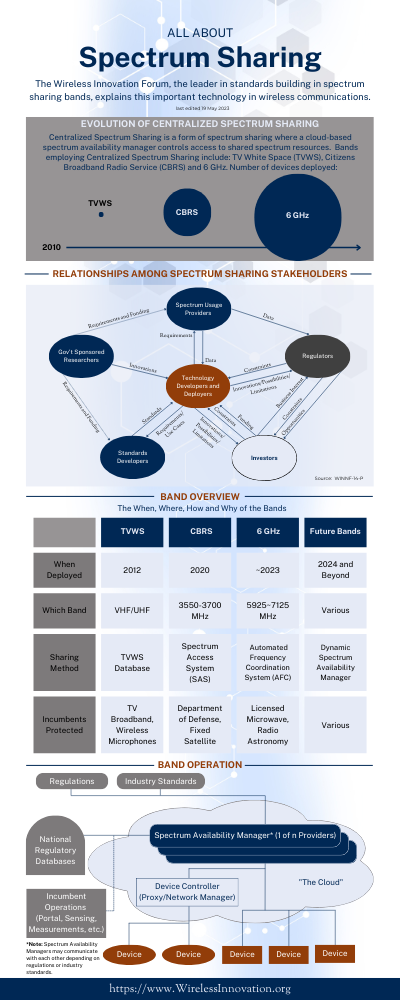- Home
- Knowledge Center
- Reports, Recommendations and Specifications
- Information Documents
- All About Spectrum Sharing Infographic
- Free Webinars
- Tech Talks
- Setting the Standard Video Blog
- Beyond the Radio Dial Video Blog
- Conference Proceedings
- Workshop Proceedings
- Springer Journals
- Market Studies
- What is the SCA?
- Issue Submissions
- Reference Implementations
- What is SDR?
- What are CR and DSA?
- About Us
- Events
- News
- Projects & Committees
- Members
- Join the Forum
Wireless Innovation Forum Top Ten Most Wanted InnovationsInnovation #9: Network Management of Mobile Ad-hoc Networks (MANET)9.1 Executive SummaryA MANET is a Mobile Ad-hoc Network which does not require network infrastructure or centralized administration. Mobile hosts in a given area dynamically connect to each other and form a network, transmitting and receiving data not only for their consumption but also acting as relays and routers for others. By enabling wireless communications with no available infrastructure, MANET technology creates valuable new capabilities for many applications, Existing network management solutions are limited, typically focused on providing network management capabilities to only a small subset of homogeneous MANET system. Since deployed systems may consist of many different networks supplied by different corporations, it is essential that the network management be able to operate across these heterogeneous solutions. This innovation topic seeks to focus interest in developing the essential technologies to provide for network management of heterogeneous ad-hoc networks for defense and commercial applications. 9.2 ApplicationManagement of a wireless ad-hoc network can be used in many ways. Network management can be used to enable real-time optimization of the allocation of network services, to manage network stability, priority, to cope with connectivity issues and to adjust various radio and network performance parameters as required by current users or applications. Network management can also be used in a non-real-time sense to enhance the radio network behavior, either in anticipation of expected traffic properties or based on experience of traffic and system behavior in a geographic region. The defense, first responder, and public safety communities recognize that in matters of emergencies and in national defense, existing infrastructure can be compromised. It is essential that radio network communications can be maintained in the absence of a dedicated, purpose built infrastructure. In such situations, we can foresee multiple MANET networks coexisting. To allow for quick and efficient deployment it is essential to provide an application for configuration and management of the multiple networks in order to obtain a single operating view. Solutions to this innovation would greatly help tying together disparate networks to be managed as a single network. 9.3 DescriptionDesigning MANETs which are highly mobile and rapidly deployable requires a means to perform distributed Network Management. Commonly network management can include adequate Management Information Base (MIB) elements that allow tracking of radios and gateways to wired infrastructure or to other networks, as well as means to provide real-time or non-real-time optimization. Network Management Systems allow limited exchanges to maintain bandwidth efficiency and support real time operations through service provisioning across the network. The challenge is to maintain the usage of bandwidth across the network while keeping network overhead as minimal as possible so that the applications can have maximum bandwidth utility of the network especially as the networks get larger. The required innovation is the development of standardized Network Management techniques for distributed MANETs. To be considered are MIBs, Simple Network Management Protocol (SNMP) structures, signaling protocols, and knowledge representations that allow the network to locally self-optimize or to be remotely optimized via an operator to enable the industry to implement standardized tools, software, and information representations, and to update network behavior and performance. Such signaling exchanges represent overhead to the user network traffic, and as such it is important to minimize the total overhead introduced by Network Management Tools. |



